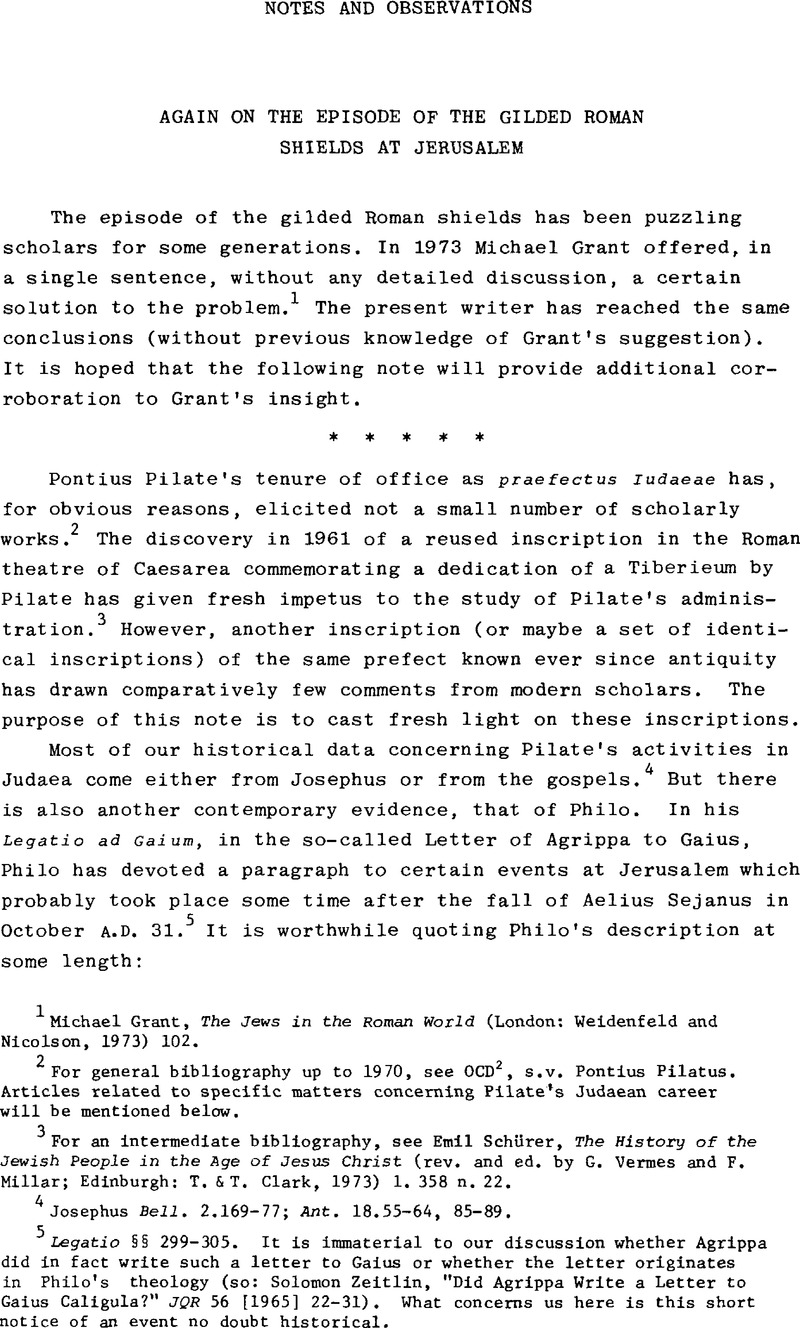Article contents
Again on the Episode of the Gilded Roman Shields at Jerusalem
Published online by Cambridge University Press: 10 June 2011
Abstract

- Type
- Notes and Observations
- Information
- Copyright
- Copyright © President and Fellows of Harvard College 1982
References
1 Grant, Michael, The Jews in the Roman World (London: Weidenfeld and Nicolson, 1973) 102.Google Scholar
2 For general bibliography up to 19 70, see OCD2, s.v. Pontius Pilatus. Articles related to specific matters concerning Pilate's Judaean career will be mentioned below.
3 For an intermediate bibliography, see Scürer, EmilThe History of the Jewish People in the Age of Jesus Christ (rev. and ed. by Vermes, G. and Millar, F.; Edinburgh: T. ST. Clark, 1973) 1. 358 n. 22.Google Scholar
4 Josephus Bell. 2.169–77; Ant. 18.55–64, 85–89.
5 Legatio §§ 299–305. It is immaterial to our discussion whether Agrippa did in fact write such a letter to Gaius or whether the letter originates in Philo's theology (so: Zeitlin, Solomon, “Did Agrippa Write a Letter to Gaius Caligula?” JQR 56 [1965] 22–31)CrossRefGoogle Scholar. What concerns us here is this short notice of an event no doubt historical.
6 Ibid., § 299, trans. Smallwood, E. Mary, Philonis Alexandrini Legatici ad Gaium (2d ed.; Leiden: Brill, 1970).Google Scholar
7 On the possible identity of these four sons, see Smallwood, Legatio, 303.
8 He was possibly afraid that the removal of the shields could have been interpreted in Rome as an insult to the emperor.
9 Bell. 2.169–74; Ant. 18.55–59.
10 For a thorough treatment of this episode, see Kraeling, Carl H., “The Episode of the Roman Standards at Jerusalem”, HTR 35 (1942) 263–89CrossRefGoogle Scholar.
11 On the date, see below.
12 Schürer;, Emil, Geschichte des jüdischen Volkes im Zeitalter Jesu Christi (Leipzig: Hinrichs, 1901) 1. 491–92.Google Scholar
13 Kraeling, “Episode”, 276–77.
14 Smallwood, Legatio, p. 302; Maier, Paul L., “The Episode of the Golden Roman Shields at Jerusalem”, HTR 62 (1969) 111–14CrossRefGoogle Scholar. In recent years, only Colson continued to maintain that these are variant traditions of a single episode: Philo, trans. Golson, F. H. (10 vols.; LCL; London: Heinemann, 1962) 10. xix-xx.Google Scholar
15 So already Schü Geschichte des jüdischen Volkes, 1. 492 n. 147.
16 Doyle, A. D., “Pilate's Career and the Date of the Crucifixion”, JTS 42 (1941) 190–93Google Scholar. See also Hoehner, Harold H., Herod Antipas (Cambridge: Cambridge University, 1972) 179–83Google Scholar; Hoehner suggests the Feast of Tabernacles of 32.
17 On the date of Pilate's dismissal, see Smallwood, E. Mary, “The Date of the Dismissal of Pilate from Judaea”, JJS 5 (1954) 12–21.CrossRefGoogle Scholar
18 Kraeling, “Episode”, 277.
19 Maier, “Episode”, 109–21.
20 Philo Legatio §§ 157,317; Josephus Bell. 2.197; C. Apion. 2.77.
21 Maier, “Episode”, 118. The reference to the shields in Alexandria: Philo Legatio § 133.
22 Brandon, Samuel George Frederick, Jesus and the Zealots (Manchester: Manchester University, 1967) 74Google Scholar. Hoehner (Herod Antipas, 179) endorsed this proposal.
23 Smallwood, Legatio, p. 304.
24 See esp. Taylor, Lily Ross, “Tiberius' Refusals of Divine Honors”, TAPA 60 (1929) 87–101.Google Scholar
25 Ibid., 93.
26 Cf., e.g., ILS nos. 113, 114, 152, 153, 155, 156, 159, 160, 164, 5818, 5829, 5829a, 6080.
27 Mattingly, Harold and Sydenham, E. A., The Imperial Roman Coinage (London: Spink and Son, 1923) 1Google Scholar.103–10 nos. 1–5, 11–25, 28–31, 37–49.
- 4
- Cited by




